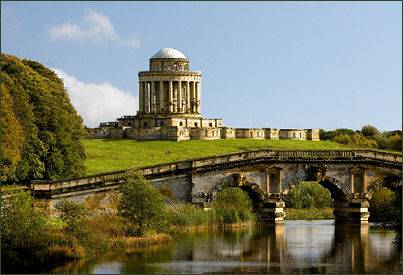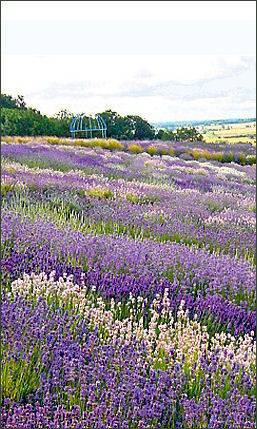The Howardian Hills
An Area of Outstanding Natural Beauty
 The stunning Howardian Hills Area of Outstanding Natural Beauty (AONB) covers 204 sq km (79 square miles) of North Yorkshire.
The stunning Howardian Hills Area of Outstanding Natural Beauty (AONB) covers 204 sq km (79 square miles) of North Yorkshire.
It is situated between the North York Moors National Park, the Yorkshire Wolds and the Vale of York. The Howardian Hills spectacular and endearing landscape boasts wooded rolling countryside, a patchwork of fields, characterful villages and historic country houses with classic parkland landscapes.
The hills take their name from the aristocratic Howard family who still own local lands, The Area of Outstanding Natural Beauty designation was confirmed in 1987.
Imposing Castle Howard (pictured below right) near York is one of the premier stately homes of England. The baroque eighteenth century masterpiece was designed by Sir John Vanbrugh for Charles Howard, 3rd Earl of Carlisle. Castle Howard occupies the site the ruined Henderskelfe Castle, which had come into the Howard family in 1566 through the marriage to Lord Dacre's widow of Thomas, 4th Duke of Norfolk. It took more than a hundred years to complete Castle Howard, but the bulk of the work was carried out between 1700 and 1710. The most dramatic feature of the building is the impressive central dome, a bold structure that had never been used to crown a private dwelling in England before. Work continued for another century, the building was only fully completed in 1811. The Yorkshire Arboretum is a stunning 120 acre garden of trees from all around the world set in a stunning landscape of parkland, lakes and ponds on the Castle Howard Estate.
 The ruins of Kirkham Priory lie in a tranquil spot on the banks of the River Derwent, at Kirkham. A former Augustinian priory, it was founded in 1130 by Walter l'Espec, lord of Helmsley, who also founded Rievaulx Abbey. Legend relates that Kirkham was founded in remembrance of l'Espec's only son who had died close to the site due to his horse being startled by a boar.
The ruins of Kirkham Priory lie in a tranquil spot on the banks of the River Derwent, at Kirkham. A former Augustinian priory, it was founded in 1130 by Walter l'Espec, lord of Helmsley, who also founded Rievaulx Abbey. Legend relates that Kirkham was founded in remembrance of l'Espec's only son who had died close to the site due to his horse being startled by a boar.
The Gatehouse of Kirkham Priory, which dates to circa .1290-5, is one of the best preserved parts of the priory site, it has a wide Gothic style arch, with sculptures of St. Bartholomew and St. Philip in niches. There are also many escutcheons with the armorials of the various benefactors of the Priory, including the arms of de Ros, Scrope, de Forz, Vaux, FitzRalph & Espec.
Historic Nunnington Hall is owned by the National Trust and stands on the banks of the River Rye. Above the house Caulkley's Bank ridge lies between Nunnington and the Vale of York to the south.The oldest part of the current house is the Stone Hall, which is part of the original sixteenth century building. This room is decorated with animal skins and hunting trophies. ord Preston's bedroom has been decorated in the style of an Edwardian dining room, and contains portraits of the Graham family. The seventeenth century Oak Hall was remodelled by Lord Preston and contains fine wooden panelling. Nunnington Hall also contains the Carlisle Collection of miniature rooms, with 16 miniature rooms, fitted out with furnishings at an eighth of their original size.
The market town of Malton is situated in Ryedale and lies to the north of the River Derwent on the historic boundary between the North and East Ridings of Yorkshire. The town is the commercial and retail centre of the local area. Malton holds a celebrated food festival, as well as having a monthly food market, Malton Cookery School, traditional food shops and 'Made in Malton' artisan producers leading to it sometimes refered to as "Yorkshire's Food Capital".
The village of Sheriff Hutton is located around six miles (10km) from York and stands on a ridge between the Vale of York and the Howardian Hills. The village's name derives from the Anglo-Saxon words hoh and tun, which mean settlement on a projecting piece of land. The prefix of Sheriff is thought to have been added because the manor was once held by Bertram de Bulmer, the Sheriff of York, who died in 1166.
Dramatic Sheriff Hutton Castle was founded as a motte and bailey castle in the Forest of Galtres by one Ansketil de Bulmer, Sherrif of York, during the reign of King Stephen. This was a Norman timber motte and bailey structure of which only the mounds now remain.
In 1331 the powerful and influential Neville family obtained overlordship of Sheriff Hutton and Bulmer's castle was rebuilt in stone in the late fourteenth century by John, Lord Neville, son of John Neville, 3rd Baron Neville de Raby. It was later inherited by his son, Richard Neville Earl of Salisbury and on his death after the Battle of Wakefield in 1460, passed to his more famous son Richard, Earl of Warwick, later known to history as 'Warwick the Kingmaker'.
 King Richard III acquired the castle from his father-in-law, Warwick, who's younger daughter Anne Neville he had married, he inherited Warwick's lands on his death at the Battle of Barnet in 1471.
In July, 1484, during the period when he served as Lord of the North, Richard III established Sheriff Hutton Castle as one of the headquarters of the Council of the North, the other was at Sandal Castle. The council was to last for a century and a half.
King Richard III acquired the castle from his father-in-law, Warwick, who's younger daughter Anne Neville he had married, he inherited Warwick's lands on his death at the Battle of Barnet in 1471.
In July, 1484, during the period when he served as Lord of the North, Richard III established Sheriff Hutton Castle as one of the headquarters of the Council of the North, the other was at Sandal Castle. The council was to last for a century and a half.
The attractive village of Slingsby is situated around 6 miles (10 km) to the west of Malton and about 2 miles to the north of Castle Howard. The village lies at the foot of gently sloping land which forms the northern edge of the Howardian Hills. Welburn is a characterful North Yorkshire village. It is situated on the edge of the Howardian Hills and on the north bank of the River Derwent. It lies 3.8 miles from the imposing Castle Howard. Walks from the village lead north into the Castle Howard Estate with its magnificent monuments and temples.
The large village of Hovingham is situated some 19 miles to the north of the city of York and lies on the edge of the Howardian Hills. Hovingham Hall was the childhood home of Katherine, Duchess of Kent, who married Prince Edward, Duke of Kent, the grandson of George V and cousin of the queen on 8 June 1961 at York Minster.
Welburn is a characterful village situated on the edge of the Howardian Hills and on the north bank of the River Derwent. It lies 3.8 miles from the imposing Castle Howard. Walks from the village lead north into the Castle Howard Estate with its magnificent monuments and temples. The highly attractive village and unspoilt of Oulston, a conservation area, lies on the edge of the Howardian Hills and is about three miles to the north-east of Easingwold. Oulston is situated in the upper part of a small valley running into the southern slopes of the Howardian Hills rising from the Vale of York.
Yorkshire Lavender (pictured right) at the pretty village of Terrington, is recognised as the area's leading, most popular, friendly and welcoming free visitor attraction.
Howsham Mill, a Grade II listed Georgian watermill, stands on a tiny island in the River Derwent at Howsham. The mill dates back to around 1755 and is attributed to the prolific English architect John Carr of York. It was built in the Gothic Revival style both as a working grist mill to grind grains into flour and as an eyecatcher or folly within the formal parkscape of nearby Howsham Hall. The mill has been restored to its former glory by the Renewable Heritage Trust and is now used as an environmental education centre, generating hydro-electricity.
